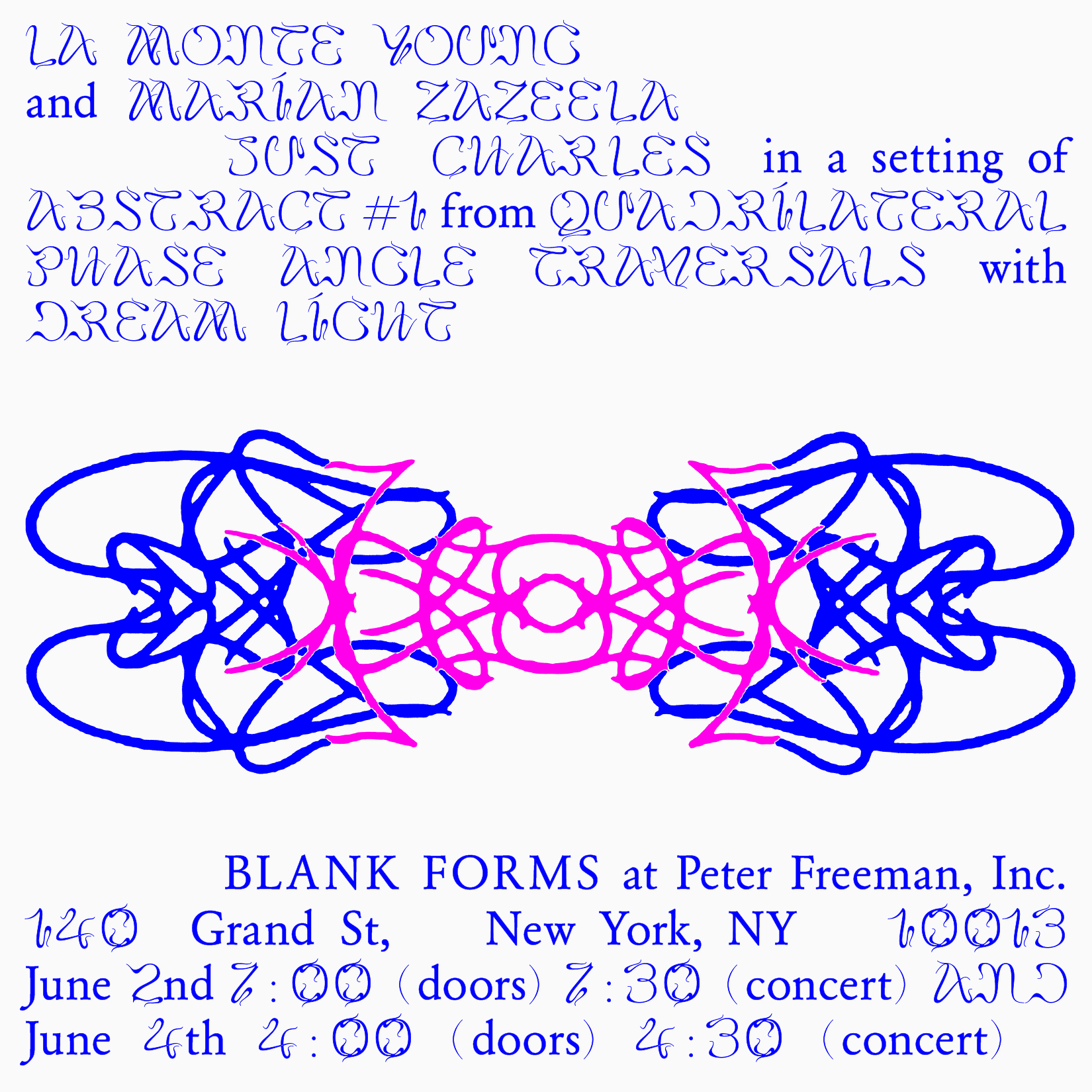June 2, 2023
7:00 (doors), 7:30pm (performance)
June 4, 2023
4:00 (doors), 4:30pm (performance)
La Monte Young and Marian Zazeela: Just Charles
La Monte Young and Marian Zazeela: Just Charles

Peter Freeman, Inc.
(Ground Floor, between Crosby and Lafayette)
New York, New York 10013
TWO SHOWS
Just Charles & Cello in the Romantic Chord, composed by La Monte Young and Marian Zazeela for cellist Charles Curtis in 2003, is a monumental essay in sustained sound and gradually shifting light projection, centered on the voice of Curtis's cello-playing, improvising within the rigorous formal framework of Young's composition. Composed in just intonation, which Young describes as “that system of tuning in which every frequency is related to every other frequency as the numerator or denominator of some whole number fraction,” Just Charles mobilizes Curtis’s capacity for exact tonal precision as he intones pitches and melodic figures over pre-recorded cello drones. Compositionally, the work expands on the “Romantic Chord” section of Young’s evolving improvisational magnum opus The Well-Tuned Piano, translating material written for Young’s specially-tuned Bösendorfer Imperial Grand into the realm of the sustaining cello. Curtis describes playing the piece as a “realtime acoustical investigation” during which the constant inflection of pitch becomes performative material, as he searches for the frequencies, intervals, and overtones that define the intonational structure. Just Charles can be seen as a bridge between The Well-Tuned Piano and Young’s works with sustained tones such as The Four Dreams of China and Trio for Strings. As on its premiere nearly two decades ago, the work will be performed within a setting of Marian Zazeela’s light environment, Abstract #1 from Quadrilateral Phase Angle Traversals with Dream Light, installed for this occasion by Jung Hee Choi, Young and Zazeela’s senior disciple. Just Charles is one of only two works conceived by Young for a soloist other than himself, along with The First Butterfly of Spring composed for Choi, begun in 2003 as a word piece.
Across nearly four decades of collaboration, Curtis and Young have built an intimate working relationship centered around study, shared music-making, and the careful re-examination of the performance practice of Young's oeuvre. The two first met in 1986, and worked together preparing a performance of Trio for Strings (1958), Young’s seminal early minimalist composition, for the thirty-year retrospective of Young's work at Dia in 1988. Curtis describes his first rehearsals with Young as “one of the foundational learning experiences of my musical life.” In the years since, he has participated in performances and premieres of more of Young’s compositions than any other interpreter.
In 2003, the ongoing collaboration between Young and Curtis coalesced in the composition of Just Charles through months of extended rehearsals at Young and Zazeela’s Church Street loft. Young, seated on the floor directly beside Curtis's cello, would sing the melodic lines to Curtis, who would then match Young’s voice on his cello, building up the work note by note until a body of material was formed. (Curtis and Young had used this method in their collaboration once before, on their arrangement of the lost early Minimalist Terry Jennings’s Piece for Cello and Saxophone in 1989). While listening in on their daily rehearsals, Zazeela made the drawings that would eventually become the constantly-transforming calligraphic projection Abstract #1 from Quadrilateral Phase Angle Traversals. Poet Louise Landes Levi, who observed Curtis’s extensive preparation for the piece’s debut, has called it “the most powerful presentation of contemporary sacred music I have ever heard, a masterpiece and a masterful rendition.
La Monte Young (b. 1935) is a world-renowned composer, performer, and artist. For over 65 years, he has pioneered the field of extended duration in music, developed the technique of just intonation, and explored the psychological and phenomenological effects of precise tuning in physical sound environments. In the summer of 1958, Young composed a seminal work, Trio for Strings, acknowledged as the first work written as musical minimalism. In 1962, Young, alongside longtime collaborator and partner Marian Zazeela, formed the short-lived group, The Theatre of Eternal Music and developed a highly influential performance practice. The members include Young, Zazeela, Terry Riley, Angus MacLise, Tony Conrad and John Cale. In 1970, Young and Zazeela supported Indian master vocalist Pandit Pran Nath’s journey to the United States, eventually spending twenty-six years under his tutelage in the Kirana style of Indian classical singing. In 1974, Young premiered his monumental, ongoing, improvisatory solo piano piece The Well-Tuned Piano in Rome on a specially-tuned Bösendorfer piano. With the support of the Dia Art Foundation, Young and Zazeela built their most expansive Dream House sound and light environment at the former New York Mercantile Exchange building, where it was open to the public from 1975 to 1985. The Dream House remains open to the public in its permanent home at MELA Foundation at 275 Church Street.
Marian Zazeela (b. 1940) is an artist working in a variety of media encompassing painting, drawing, graphic design, film, light projection, stage design, sculpture and environment. Over the past six decades, she has developed a singular visual language, incorporating her signature calligraphic iconography within highly saturated colored-light environments in which light, sculptural form, and phenomenological effect feed into each other to create a total experience. Working closely alongside her partner La Monte Young since 1962, Zazeela’s light environments and graphic design have formed the visual language of virtually all of Young’s major output, from posters and records to the Dream House sound and light environment across each of its iterations. Zazeela began singing with Young in 1962 as a founding member of The Theatre of Eternal Music, and performed as vocalist in almost every concert of Young’s ensemble. In 1970, she became one of the first Western disciples of renowned master vocalist Pandit Pran Nath and has since performed and taught the Kirana style of Indian classical music. She accompanied Pandit Pran Nath in hundreds of concerts throughout the world and continues to perform in The Just Alap Raga Ensemble and The Sundara All Star Band, which she founded with Young and Jung Hee Choi. Abstract #1 from Quadrilateral Phase Angle Traversals consists of a projection of abstracted letter forms which gradually metamorphose in quadrilateral symmetry over the duration of the performance, itself bathed in the light of her Dream Light performance environment, created specifically for the concert performance of Young’s music. Zazeela’s installations, works on paper, and performances have been presented by major American and European institutions, most recently at Dia Beacon from 2019–2022.
Charles Curtis (b. 1960) is among the premiere avant-garde cellists living today. A graduate of Julliard, Curtis has woven a unique and storied career through the worlds of both classical and experimental music. Among La Monte Young’s closest and most enduring collaborators, Curtis has devoted much of his musical life to the realization and interpretation of Young's music, from whom he learned just intonation, improvisation, and the Kirana style of Indian classical music. Curtis also attended classes with the late master vocalist Pandit Pran Nath, and performed in the Just Alap Raga Ensemble directed by Young and Marian Zazeela. He has led numerous performances of Young's work throughout Europe and the U.S., including all of the Four Dreams of China, a Subsequent Dream of China, a number of the Compositions 1960, and most importantly Trio for Strings, Young's 1958 composition now universally acknowledged as the first work of minimalism in music. In consultation with Young, Curtis devised the just intonation tuning and the originally intended Longer Duration version of Trio, premiered at the Dia:Chelsea Dream House in 2015 and released as a 4-LP box set by Dia in 2021. Curtis is also one of only a handful of musicians to have appeared in duo formations with Young, performing Richard Maxfield's Perspectives for La Monte Young for low string instrument and tape, and Terry Jennings's Piece for Cello and Saxophone, recently released on Saltern Records in a solo cello version made by Young expressly for Curtis. He has performed modern classical, minimalist, and chamber music compositions all around the world. Numerous major composers—Alvin Lucier, Éliane Radigue, Christian Wolff, Alison Knowles and Tashi Wada among them—have written works specifically for him. Curtis is Distinguished Professor of Music at the University of California, San Diego. Recent releases include Performances and Recordings 1998–2018 and two complete performances of Radigue's hour-long solo, Naldjorlak, her very first work for an acoustic instrument and a live performer, on Wada's Saltern label.
Jung Hee Choi (b. 1969) works across a variety of media, including drawing, video, photography, sculpture, performance, sound, and multi-media installation. Choi received her MA in art and sound from New York University. She became a disciple of La Monte Young and Marian Zazeela in 1999, with the traditional Kirana gandha bandh red-thread ceremony taking place in 2003. Young and Zazeela’s primary adherent, Choi has participated in and directed the presentation of their installations and performances around the world. In 2002, she co-founded the Just Alap Raga Ensemble with Young and Zazeela, which Young calls the primary vehicle of his work. The three artists have performed together extensively since 2002 presenting live performances with their ensembles; The Just Alap Raga Ensemble, The Sundara Trio, The Sundara All Star Band, and the reborn Theatre of Eternal Music. Choi’s solo exhibitions were presented annually from 2009 through 2017 in the Dream House, curated by Young and Zazeela, the only long-term installations other than their original environment. Since 2018, Choi’s works have been presented simultaneously with Young and Zazeela’s in the Dream House, forming a continuous and collaborative sound and light environment. She has exhibited and performed widely in the U.S., Europe and Asia, including at Dia Art Foundation, the Guggenheim Museum, Berliner Festspeile, FRESH Festival in Bangkok, FRAC Franche-Comté, and Bundeskunsthalle.
Peter Freeman, Inc. is wheelchair accessible with a short ramp to the main entrance. There is an additional entry point with a longer ramp that can be accessed with the assistance of gallery staff. For further access information, please contact info@peterfreemaninc.com or call 212-966-5154.

